Posts Tagged restaurants
We The People Opportunity Farm and Plum Market Kitchen at The Henry Ford

Melvin Parson Gardening during the Entrepreneurship Interview, April 5, 2019 / THF295401
Our culinary team at The Henry Ford is continuously inspired by the stories we tell from our collections and the modern-day changemakers we have the privilege to work with. We’re also always looking for partners whose goals mesh with The Henry Ford’s goals for our food programming. Executive Chef David McGregor of The Henry Ford notes those include “understanding the connection that we have with the food we consume and passing this knowledge down to future generations to ensure a sustainable food system,” as well as “taking the time to understand the seasonality of the food grown in your region and building relationships with local farmers and artisans to create menus that reflect that availability as the seasons change.”
Last year the team created a series of recipes inspired by the work of George Washington Carver; this fall we worked with local farmer and social entrepreneur Melvin Parson, utilizing the products from his farm at The Henry Ford in Plum Market Kitchen. Parson is no stranger to The Henry Ford. As the founder of We The People Opportunity Farm, he was the Spring 2019 Entrepreneur in Residence at The Henry Ford, funded by the William Davidson Foundation Initiative for Entrepreneurship.
Learn more about Parson and his vision for change:
- How Melvin Parson Created an Urban Farming Initiative
- Melvin Parson: Market Gardener and Social Entrepreneur
- Innovation Journey with Melvin Parson
- Agriculture Pioneer Melvin Parson
We worked with Parson and his farm this fall to provide locally sourced ingredients in our restaurants, like those found in our Heirloom Tomato Salad with White Wine Vinaigrette. Enjoy it during a visit to Plum Market Kitchen, and then try making it on your own at home.
Heirloom Tomato Salad with White Wine Vinaigrette (serves many)
Ingredients: Tomato Prep
- 15 heirloom tomatoes
- 2 yellow onions, julienned thin
- 1 cup white wine vinaigrette
- 1 cup basil chiffonade
- 1 tbsp salt
- 1 tsp black pepper
Ingredients: Vinaigrette
- 2 cups olive oil
- 1 cup white wine vinegar
- 6 garlic cloves, minced
- 1 tbsp fresh parsley, chopped
- ½ tsp dried basil
- 1 tsp kosher salt
- ½ black pepper
METHOD: Salad
- Cut tomatoes into 1” chunks and place in a colander for a few minutes to drain excess moisture.
- Place tomatoes in a large bowl with other dry ingredients.
- Fold in Dressing for service, being careful to keep the tomato pieces intact.
METHOD: Vinaigrette
- Add all ingredients except oil and blend until smooth
- Slowly add oil while blending until everything is incorporated.
Lish Dorset is former Marketing Manager, Non-Admission Products, at The Henry Ford.
by Lish Dorset, farms and farming, entrepreneurship, recipes, restaurants, food

Photo by KMS Photography
When it comes to dining experiences, Eagle Tavern in Greenfield Village is one of a kind. The stagecoach tavern was built in 1831 in Clinton, Michigan. Calvin Wood and his wife Harriet operated it from 1849 to 1854, offering food, drink, and accommodations to the locals and those who came through the town. In 1927, Henry Ford purchased the tavern and brought it to Greenfield Village as the Clinton Inn, where it first served as a cafeteria for Edison Institute students and then for visitors. In April 1982, Eagle Tavern officially opened as the restaurant we know today. Forty years later, Eagle Tavern continues to delight members and guests with mid-1800s food and drink.
As we celebrate the beginning of the 2022 Greenfield Village season, Sous Chef Kasey Faraj shares three of his favorite Eagle Tavern recipes for you to try at home.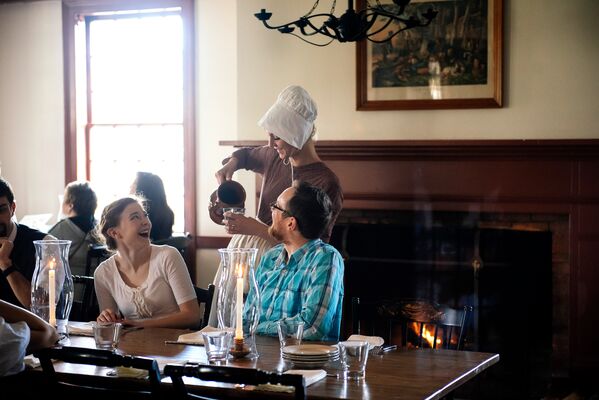
Photo by Emily Berger
“My absolute favorite thing about the tavern is the overall guest experience,” said Faraj. “There is simply no place like this anywhere in America where we are taking our guests on a journey to the past. Everything from our Calvin and Harriet Wood characters chatting with our guests to the food, to the look of the bill of fare and restaurant, and the servers in period clothing, we all collectively create an experience that is unique, historically accurate, and unmatched by any establishment.”
Faraj found inspiration for his menus from classic mid-1800s era cookbooks, like Mrs. Putnam’s Receipt Book and The Kentucky Housewife. It was in these wonderful books that he was inspired to create dishes such as our delicious Asparagus Soup, Pork and Potato Balls, and Bouilli Beef.
Eagle Tavern’s Asparagus Soup
serves many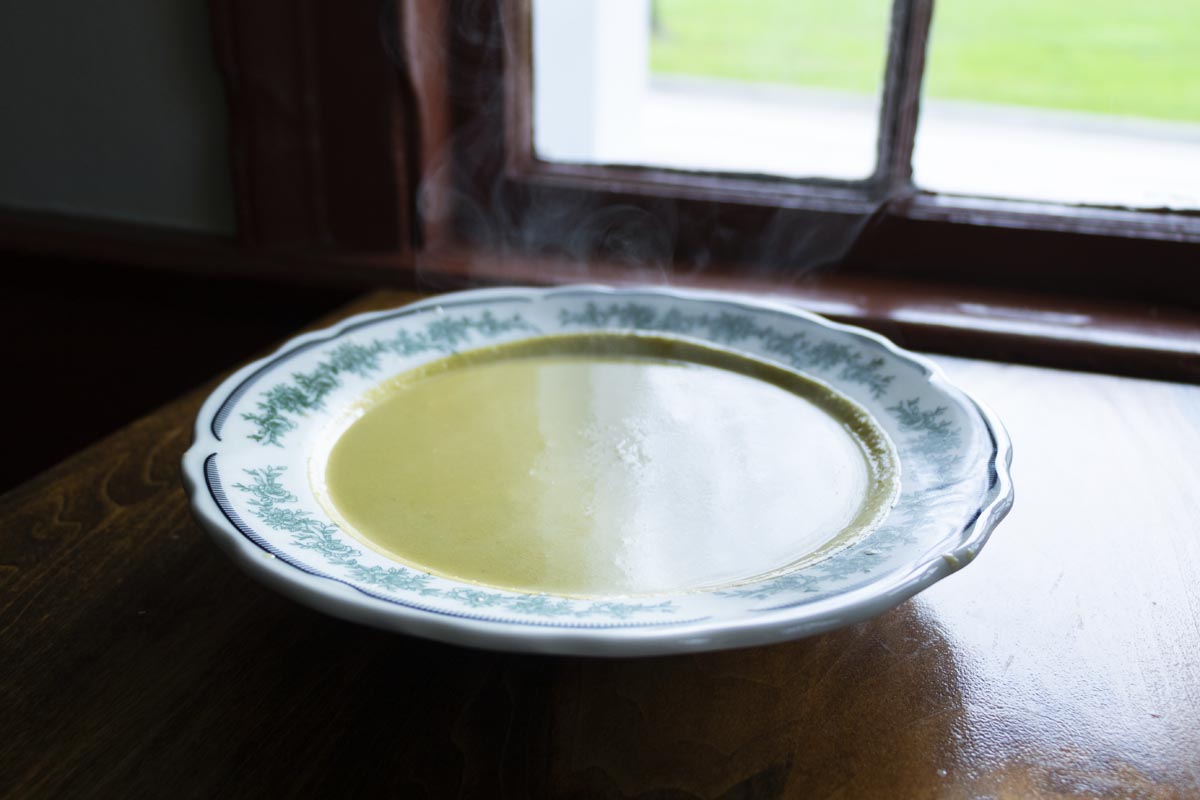
Ingredients
- ½ pound unsalted butter
- 1 ½ cups yellow onion, medium dice
- 1 teaspoon fresh garlic, minced
- 5 pounds asparagus, trimmed
- 1 ½ cups celery, diced
- 2 bay leaves
- ¾ gallon vegetable broth
- ½ cup cornstarch
- 1 quart half-and-half
- Salt and pepper to taste
Method
- Heat a stockpot and melt the butter.
- Add the onions and garlic and cook over medium-high heat until onions are translucent.
- Add the asparagus, celery, bay leaves, and vegetable broth. Bring to a boil.
- Once boiling, turn heat to low and simmer until asparagus is tender.
- Add the cornstarch and half-and-half and puree the mixture with a hand blender until smooth. (You can also slowly break down the asparagus with a potato masher.)
- Add salt and pepper to your liking.
- Adjust the cornstarch if thicker or thinner soup is desired.
- Strain if you wish to have a lighter-style soup. Serve with fresh bread or crackers.
“The awesome curators here at The Henry Ford and I collaborate to find these menu items in cookbooks from the past,” said Faraj. “I then take said items and build the menu through both seasonal availability and the story of Harriet and Calvin Wood. It is not as simple as, ‘I found a recipe for a mid-1800s era style corn soup, so we are going to offer that soup.’”
Faraj and team take everything into consideration:
- How did season and local availability influence the meals that a tavernkeeper like Harriet Wood might have prepared for her tavern customers?
- What foodstuffs could have been imported in southern Michigan in 1850?
- What type of meals and desserts might Harriet Wood have had time to prepare over an open hearth in her busy tavern kitchen?
“In-depth research from period American cookbooks found in our research center, and expertise from our curators, help us find our way to these answers,” he said. “The ability to find a recipe from a book written almost two centuries ago, test that recipe, and then place it on a menu (that is seasonally accurate!) is what makes a chef working in historic dining challenging—yet fun!”
Eagle Tavern’s Pork and Potato Balls
serves many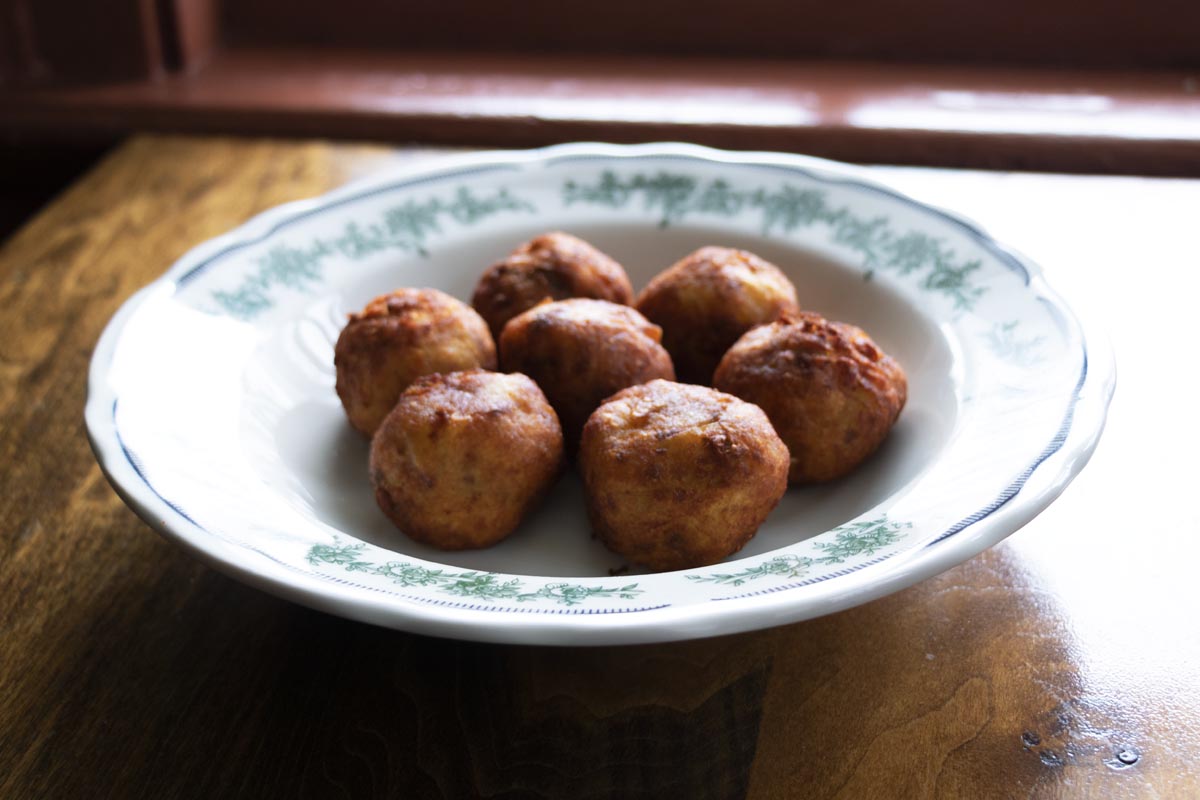
Ingredients
- 3 pounds cooked Idaho potatoes
- 3 fresh eggs
- 1 pound cooked pork-sage sausage, crumbled
- Salt and pepper to taste
- 1 pound unsalted butter
Method
- Put cooked potatoes in a large mixing bowl. Using a potato masher, mash the potatoes until there are very few lumps.
- In a separate bowl, whisk the eggs.
- Add the crumbled sausage, salt, and pepper to the eggs and mix until evenly distributed.
- Using a spoon or a small scooper, shape the mix into small balls no larger than a golf ball.
- Heat a nonstick pan and melt the butter.
- Cook the balls in the butter until browned on all sides and the internal temperature is 165° F. When cooked, sprinkle with additional salt and pepper and serve with extra butter, if desired.
One last recommendation from Chef Faraj: Eagle Tavern’s Bouilli Beef. “This dish is great served with roasted potatoes and mashed parsnips,” he said.
Eagle Tavern’s Bouilli Beef
serves many
Ingredients
- 3 pounds beef, cut into 8-oz. portions (preferably chuck eye roll)
- Salt and pepper to taste
- 3 ounces vegetable oil
- 1 pound turnips, cut into 1-inch pieces
- ¼ pound yellow onion, medium dice
- ¼ pound peeled carrots, medium dice
- ¼ pound celery, medium dice
- 1 ½ gallons beef stock
- 2 bay leaves
- ½ teaspoon ground cloves
- 6 cloves fresh garlic
- 1 ounce soy sauce
- 2 ounces Dijon mustard
- 4 ounces cornstarch
- 4 ounces chopped sweet pickles
Method
- Season the beef with salt and pepper. Heat the vegetable oil in a stockpot on the stove and sear the meat on all sides.
- Add the rest of the ingredients except for the soy sauce, mustard, cornstarch, and pickles.
- Bring it all to a boil; once boiling, turn the heat down to a low setting and cover. Let cook slowly until the meat is almost fall-apart tender, 2-3 hours. Turn off and leave on stove.
- Take half the stock the beef was cooked in and strain. Whisk together the soy sauce, mustard, and strained stock in a small saucepot over medium heat. Add the cornstarch and bring to a slow boil; cook until gravy is slightly thick. Add the cooked beef and plate with the turnips it was cooked with.
- Ladle 2-3 ounces of gravy over each piece and top with chopped pickles.
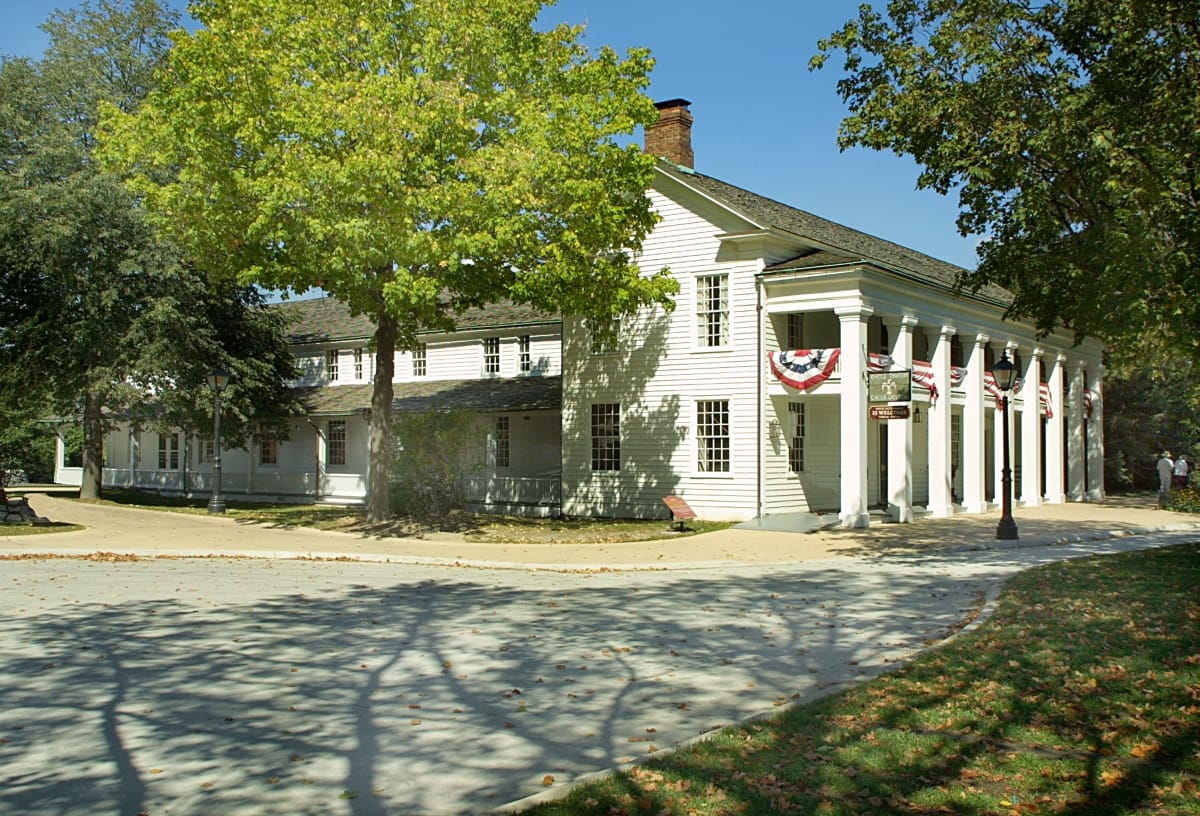
Eagle Tavern, Greenfield Village / THF1918
Want to learn more about Eagle Tavern? Look below for links to blog posts, Innovation Nation segments, and artifact records.
All About Eagle Tavern
- Artifact Record: Eagle Tavern
- Plan Your Visit
- Creating the Eagle Tavern Dining Experience
- The Henry Ford’s Innovation Nation: 1850s Dining Experience at Eagle Tavern
- 1988 Eagle Tavern Cookbook
Drink Recipes
Dig Deeper
- Greenfield Village Building Makeovers
- Meet Calvin Wood
- Drinking at Eagle Tavern
- Root Vegetables, Now & Then
- Behind the Bar at Eagle Tavern
Lish Dorset is Marketing Manager, Non-Admission Products, at The Henry Ford.
making, Michigan, recipes, food, restaurants, by Lish Dorset, Greenfield Village buildings, Greenfield Village, Eagle Tavern
Celebrating Lamy’s Diner
 Photo by Emily Berger
Photo by Emily Berger
This month we are excited to reopen a guest favorite inside Henry Ford Museum of American Innovation: Lamy's Diner, a must-stop destination closed for almost two years during the COVID-19 pandemic. Operating as a restaurant inside the museum since 2012, Lamy’s provides members and guests an authentic 1940s diner experience, complete with chicken salad sandwiches and frappes. (And Toll House chocolate chip cookies, of course!)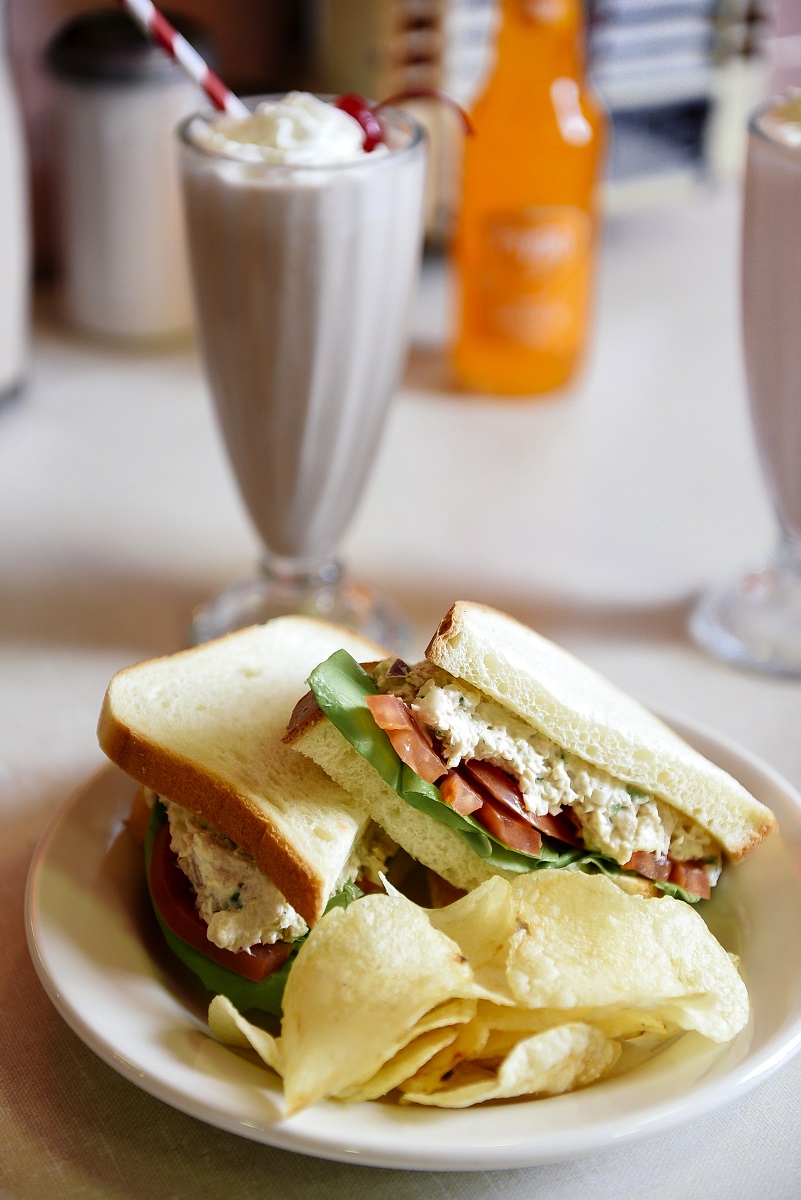
Photo by Emily Berger
In honor of Lamy’s reopening for daily dining, Eric Schilbe, Executive Sous Chef at The Henry Ford, shares two recipes that are crowd pleasers on the menu: tomato soup (an occasional special) and maple chicken salad. Try making these favorites at home, and then dig deeper into all-things Lamy’s in our Digital Collections.
Recipes
Lamy’s Tomato Soup
Makes about 4-5 bowls
Why we use this recipe:This is a very traditional tomato soup that has plenty of vegetable flavor and a touch of richness from the Parmesan cheese. (Psst! Don’t add the cheese until the very end!)
Ingredients
- 2T olive oil
- 1 large onion, diced
- 4 stalks small diced celery
- 2 carrots, chopped
- 1 bay leaf
- 1t dried basil
- 2 large cans diced tomato (plain – no seasoning)
- 1 cup half-and-half
- 1t pepper
- ¼ cup Parmesan cheese
Directions
- Cook the onions, carrots, and celery with oil in a stainless pot until completely tender.
- Add tomatoes, bay leaf, basil, and simmer about 30-40 minutes until completely cooked. (It should be a little darker than when you started.)
- Finish with half and half, Parmesan cheese, and pepper. Remove from heat.
- Using a blender, blend the soup until very smooth, and then serve immediately.
Chef’s Notes
- All canned tomatoes are not created equal! You may need to adjust with a little water or cook them down longer.
- Cook your vegetables until they are completely tender and falling apart—this will add richness to the flavor.
Lamy’s Maple Chicken Salad
Makes about 4-5 sandwiches
Why we use this recipe: Chicken salad can be such a simple recipe, but by adding maple syrup, a classic New England ingredient, and a touch of cumin, we set it apart from others.
Ingredients
- 2 large chicken breasts, cooked and cooled
- 4 stalks small diced celery
- ¼ minced red onion
- 1T yellow mustard
- 1T pure maple syrup
- ¼ cup mayonnaise
- 2T sour cream
- 1/4t cumin
- 1T fresh parsley, chopped fine
- 1t pepper
Directions
- Cook, cool, and pick the chicken. Place in a food processor and pulse until shredded fine.
- Add all other ingredients together and mix well.
- Let set, refrigerated, for 1-2 hours before serving.
Chef’s Notes
- During this era, the chicken was typically shredded very fine and simple ingredients were used. When making this at home, make sure the chicken is not overcooked and that it is very well shredded. This will make the salad moist and flavorful; you can always add a touch more mayonnaise.

Photo by Emily Berger
Dig Deeper: Lamy's Online
All About Lamy’s
- Plan Your Visit: Lamy’s Diner (find notes on visiting and hours)
- Lamy’s Diner, 1946 (check out the Lamy’s artifact page in our Digital Collections)
- Lamy’s: A Diner from the Golden Age (explore the history of Lamy’s on our blog)
- Lamy’s Gets a Makeover (2017) (learn about our 2017 updates to Lamy’s menu; note that additional changes have been made since)
- Lamy’s on TV: Mr. Coffee – The Henry Ford’s Innovation Nation
Diners, Drive-Ins... and Cookies
- Diners: An American Original (dig into the history of the diner on our blog)
- Dig Deeper: Owl Night Lunch Wagon (explore artifacts related to Greenfield Village’s own Owl Night Lunch Wagon)
- Inventing America’s Favorite Cookie (find out how America’s favorite cookie, the Toll House chocolate chip cookie, was born)
- Flipping Burgers into a Career (learn the story of Don Dunivent, who worked for White Castle from the 1920s through the 1950s)
- Dig Deeper: Lunch Wagons (check out artifacts related to lunch wagons in our Digital Collections)
More Historic Dining at The Henry Ford
- Creating the Eagle Tavern Dining Experience (go behind-the-scenes to learn how we developed the menu for Greenfield Village’s Eagle Tavern)
- Beyond the Peanut: Food Inspired by Carver (discover how agricultural scientist George Washington Carver’s own recipes provided inspiration for some of our recipes at A Taste of History and Plum Market Kitchen)
Lish Dorset is Marketing Manager, Non-Admission Products, and Eric Schilbe is Executive Sous Chef at The Henry Ford.
Additional Readings:
- Lamy's Diner
- Lamy's: A Diner from the Golden Age
- Lamy's Diner at Its Original Site in Marlborough, Massachusetts, circa 1946
- Diners: An American Original
COVID 19 impact, recipes, by Eric Schilbe, by Lish Dorset, food, Driving America, Henry Ford Museum, diners, restaurants
Native Flavors Trailblazer: Chef Brian Yazzie
Catch a glimpse of Brian Yazzie’s left arm, and you’ll see cranberries, sumac, and sunflowers near his wrist, blue Hopi corn on his forearm and Navajo squash holding court at his elbow. An illustrated sleeve of more produce and wild game are up next for the right.
Chef Brian Yazzie. / Photo courtesy Brian Yazzie
The inspiration behind the ever-growing tattooed bounty of Native American produce started at age 7 for Yazzie, when the aromatics of Navajo blue corn mush or the sound of a knife tapping on a cutting board drew him into the kitchen to help cook for his large family. Raised by a single mother in Dennehotso, Arizona, located on the northeast part of the Navajo Nation, Yazzie remembers eating traditional and freshly foraged foods like wild spinach and pine nuts but also commodity foods like government cheese, canned chicken, and powdered milk.
“That was what we grew up on,” said Yazzie. “But for me, as long as we had food, we were OK.”
He discovered his passion for cooking but at the time was equally lured into gang life, spending his teenage years in and out of detention centers and county jails and skipping classes, sometimes to just hide out in the home economics classroom.
“I was blessed never to end up in prison or passing on,” said Yazzie, whose sisters would call to tell him to come home because they missed his food. “That was their way of checking up on me. Cooking always kept me out of trouble; it’s what saved my life.”
It’s also what prompted Yazzie and his wife, Danielle Polk, to settle in the Twin Cities in 2013. They wanted opportunity but also to stay connected to Native communities. “The Twin Cities has one of the top five Native urban populations in the U.S.,” said Yazzie, who works closely with the Dakota and Ojibwe tribes there while continuing to help the Dennehotso reservation and other tribal communities around the United States.
In 2014, Yazzie enrolled at Saint Paul College, where his first assignment as a culinary student was to perfect any dish from around the world. “I wanted to make something beyond frybread, but I realized at least 50% of ingredients inside Navajo tacos are native to the Americas,” said Yazzie.
Toppings like summer squash, peppers, and eggplant reminded him of French ratatouille, and he found his dish. More importantly, he discovered the larger influence of Indigenous foods and his passion for reviving, celebrating, and recognizing their ancestral origins.
Chef Yazzie found inspiration in eggplant, summer squash, and peppers, like the one on this circa 1951 seed packet from our collection, during his first assignment as a culinary student. / THF294269
He and Polk started a Native American Club on campus and connected with local chef/author/educator Sean Sherman, CEO of The Sioux Chef, to cater one of their events. “Seventy-five percent of the appetizers he served were foreign to me,” said Yazzie, who went on to work for Sherman before he and Polk started their own catering company, Intertribal Foodways. “We wanted to bring awareness to what’s been overlooked for so long.”
Along with showcasing Native ingredients and techniques, that’s also meant addressing health issues like diabetes that have long affected Indigenous communities. “We try to implement food as medicine,” said Yazzie, now executive chef of the Gatherings Cafe inside the Minneapolis American Indian Center. “Especially during this pandemic, we have to keep our elders strong and safe; a lot of them hold lost languages and teachings.”
After COVID-19 hit, Yazzie and his team started making 200 healthy meals a day for elders in the Twin Cities, established a Dennehotso COVID-19 relief fund, and regularly sent healthy food and supplies to the Apache County community. He works with local farmers and foragers to bring Native ingredients into his food whenever he can, even if it means taking baby steps with dishes like unhealthy frybread (created by Yazzie’s Navajo ancestors while they were in internment camps at Fort Sumner, New Mexico, in the 1860s). “It’s still on the table across North America as a survival staple for tribal communities, especially during the pandemic, so I had to take a step back and listen to my elders, but we’re getting there,” said Yazzie, who lightens up the wheat-heavy bread with amaranth flour or wild rice flour.
Continue Reading
21st century, 2020s, Indigenous peoples, The Henry Ford Magazine, restaurants, recipes, healthcare, food insecurity, food, COVID 19 impact, by Liz Grossman
Eagle Tavern Happy Hour: Maple Bourbon Sour Recipe

This summer, we’re highlighting some of the cocktails and nonalcoholic “temperance beverages” that are available at Eagle Tavern in Greenfield Village. Inspired by history but with a modern flair, these drinks pay homage to the Eagle Tavern barroom’s Michigan history as a sort of “community center.” We’d love for you to stop by and try one of these refreshing concoctions for yourself—or try making them at home. Today’s feature is the Maple Bourbon Sour.
Maple Bourbon Sour
Fill a 12 oz glass with ice.
Add 1 oz bourbon and ½ oz Michigan maple syrup.
Fill to the top with Michigan-made lemonade.
Additional Readings:
- Menu from Clinton Inn (now Eagle Tavern), Greenfield Village, 1952
- Root Vegetables, Then and Now
- Eagle Tavern Happy Hour: Mint Iced Tea Recipe
- Behind the Bar at Eagle Tavern
making, restaurants, Greenfield Village buildings, Greenfield Village, Eagle Tavern, beverages, recipes
Eagle Tavern Happy Hour: Mint Iced Tea Recipe

This summer, we’re highlighting some of the cocktails and nonalcoholic “temperance beverages” that are available at Eagle Tavern in Greenfield Village. Inspired by history but with a modern flair, these drinks pay homage to the Eagle Tavern barroom’s Michigan history as a sort of “community center.” We’d love for you to stop by and try one of these refreshing concoctions for yourself—or try making them at home. Today’s feature is nonalcoholic Mint Iced Tea.
Mint Iced Tea
Fill a 12 oz glass with ice.
Add 10 oz of Michigan-made brewed mint tea.
Garnish with a fresh mint sprig.
Additional Readings:
- Eagle Tavern Happy Hour: Nonalcoholic Cherry Effervescing Recipe
- Eagle Tavern Harvest Supper
- Eagle Tavern Cookbook, 1988
- Making Eagle Tavern's Butternut Squash Soup
recipes, restaurants, making, Greenfield Village buildings, Greenfield Village, Eagle Tavern, beverages
Eagle Tavern Happy Hour: Stone Wall Recipe

This summer, we’re highlighting some of the cocktails and nonalcoholic “temperance beverages” that are available at Eagle Tavern in Greenfield Village. Inspired by history but with a modern flair, these drinks pay homage to the Eagle Tavern barroom’s Michigan history as a sort of “community center.” We’d love for you to stop by and try one of these refreshing concoctions for yourself—or try making them at home. Today’s feature is the Stone Wall.
Stone Wall
Fill a 12 oz glass with ice.
Add 1 oz rum.
Fill to the top with Michigan-made hard cider.
Additional Readings:
- Meet Calvin Wood, Caterer of Eagle Tavern
- Eagle Tavern Happy Hour: Maple Bourbon Sour Recipe
- Eagle Tavern Harvest Supper
- Creating the Eagle Tavern Dining Experience
making, restaurants, Greenfield Village buildings, Greenfield Village, Eagle Tavern, beverages, recipes
Eagle Tavern Happy Hour: Nonalcoholic Cherry Effervescing Recipe

This summer, we’re highlighting some of the cocktails and nonalcoholic “temperance beverages” that are available at Eagle Tavern in Greenfield Village. Inspired by history but with a modern flair, these drinks pay homage to the Eagle Tavern barroom’s Michigan history as a sort of “community center.” We’d love for you to stop by and try one of these refreshing concoctions for yourself—or try making them at home. Today’s feature is the nonalcoholic Cherry Effervescing.
Cherry Effervescing
Fill a 12 oz glass with ice.
Add 2 oz cherry syrup.
Fill to the top with soda water.
Additional Readings:
- Eagle Tavern Happy Hour: Maple Bourbon Sour Recipe
- Eagle Tavern Happy Hour: Stone Wall Recipe
- Eagle Tavern Inspiration to Enjoy at Home
- Root Vegetables, Then and Now
recipes, Greenfield Village buildings, Greenfield Village, Eagle Tavern, restaurants, making, beverages
Eagle Tavern Happy Hour: Mint Julep Recipe

This summer, we’re highlighting some of the cocktails and nonalcoholic “temperance beverages” that are available at Eagle Tavern in Greenfield Village. Inspired by history but with a modern flair, these drinks pay homage to the Eagle Tavern barroom’s Michigan history as a sort of “community center.” We’d love for you to stop by and try one of these refreshing concoctions for yourself—or try making them at home. Today’s feature is the Mint Julep.
Mint Julep
In a 9 oz glass, muddle the leaves from 2 sprigs of mint.
Add 4 seconds of a pour of sugared water, and continue to muddle.
Fill with cracked ice, then add 1 jigger of bourbon or brandy, and 2 brisk dashes of bitters (to taste).
Stir well and garnish with mint.
Additional Readings:
- Eagle Tavern Happy Hour: Nonalcoholic Cherry Effervescing Recipe
- Drinking at Eagle Tavern
- Meet Calvin Wood, Caterer of Eagle Tavern
- #THF90: Creating Greenfield Village
making, restaurants, Greenfield Village buildings, Greenfield Village, Eagle Tavern, beverages, recipes

This summer, we’re highlighting some of the cocktails and nonalcoholic “temperance beverages” that are available at Eagle Tavern in Greenfield Village. Inspired by history but with a modern flair, these drinks pay homage to the Eagle Tavern barroom’s Michigan history as a sort of “community center.” We’d love for you to stop by and try one of these refreshing concoctions for yourself—or try making them at home. Today’s feature is the Lemon & Ginger Shrub.
Lemon & Ginger Shrub
Fill a 12 oz glass with ice.
Add 1 oz Michigan-made vodka and 2 oz Michigan-made McClary Lemon Ginger Shrub mix.
Fill to the top with soda water.
Additional Readings:
- Eagle Tavern at its Original Site, Clinton, Michigan, February 2, 1925
- Behind the Bar at Eagle Tavern
- Eagle Tavern Happy Hour: Stone Wall Recipe
- Just Added to Our Digital Collections: Eagle Tavern Images
making, restaurants, Greenfield Village buildings, Greenfield Village, Eagle Tavern, recipes, beverages

